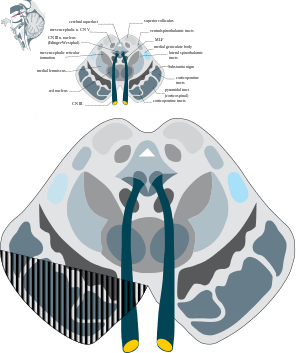Weber's syndrome
Weber's syndrome, also known as superior alternating hemiplegia, is a form of stroke characterized by the presence of an ipsilateral oculomotor nerve palsy and contralateral hemiparesis or hemiplegia. It is caused by midbrain infarction as a result of occlusion of the paramedian branches of the posterior cerebral artery or of basilar bifurcation perforating arteries.[1]
| Weber's syndrome | |
|---|---|
| Other names | Superior alternating hemiplegia |
 | |
| Midbrain cross section showing lesion | |
| Specialty | Neurology |
| Treatment | anything which can decrease the stroke's effect |
Cause
This lesion is usually unilateral and affects several structures in the midbrain including:
| Structure damaged | Effect |
|---|---|
| substantia nigra | contralateral parkinsonism because its dopaminergic projections to the basal ganglia innervate the ipsilateral hemisphere motor field, leading to a movement disorder of the contralateral body. |
| corticospinal fibers | contralateral hemiparesis and typical upper motor neuron findings. It is contralateral because it occurs before the decussation in the medulla. |
| corticobulbar tract | difficulty with contralateral lower facial muscles and hypoglossal nerve functions |
| oculomotor nerve fibers | ipsilateral oculomotor nerve palsy with a drooping eyelid and fixed wide pupil pointed down and out. This leads to diplopia |
It is caused by midbrain infarction as a result of occlusion of the paramedian branches of the posterior cerebral artery or of basilar bifurcation perforating arteries.[2]
Diagnosis
Clinical findings mainly eyeball is down and out ipsilateral lateral squint. Ptosis present. Pupil dilated and fixed as the levator palpebrae superioris nerve supply is disrupted. Contralateral hemiplegia CT scan or MRI might help in delineating the cause or the vessel or region of brain involved in stroke.
Management
History
It carries the name of Sir Hermann David Weber, a German-born physician working in London, who described the condition in 1863.[3][4] It is unrelated to Sturge-Weber syndrome, Klippel-Trenaunay-Weber syndrome or Osler-Weber-Rendu syndrome. These conditions are named for his son Frederick Parkes Weber.
See also
References
- "Weber's syndrome". GPnotebook.
- "Weber's syndrome". GPnotebook.
- Weber HD (1863). "A contribution to the pathology of the crura cerebri". Medico-Chirurgical Transactions. 46: 121–139. doi:10.1177/095952876304600112. PMC 2147786. PMID 20896209.
- Weber's syndrome at Who Named It?